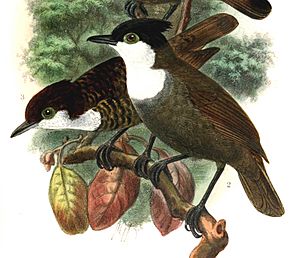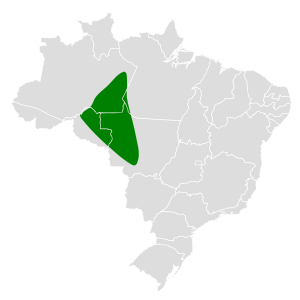White-breasted antbird facts for kids
Quick facts for kids White-breasted antbird |
|
|---|---|
 |
|
| Conservation status | |
| Scientific classification | |
| Genus: |
Rhegmatorhina
|
| Species: |
hoffmannsi
|
 |
|
The white-breasted antbird (Rhegmatorhina hoffmannsi) is a small, special bird that lives only in Brazil. It's known for its unique way of finding food in the forest. This bird is part of the Thamnophilidae family, which includes many types of antbirds.
Contents
White-breasted Antbird: A Forest Friend
This amazing bird gets its name from the white feathers on its chest. It's a shy creature that prefers to stay hidden in the dense parts of the forest. Scientists first described this species in 1907.
Where It Lives
The white-breasted antbird calls the warm, wet lowland forests of Brazil its home. These are often called subtropical or tropical moist forests. They are full of tall trees, thick plants, and lots of different animals. This bird is endemic to Brazil, meaning you won't find it living naturally anywhere else in the world. Its home is usually near the Amazon River basin.
What It Eats
Unlike many birds that hunt insects on their own, the white-breasted antbird has a very clever trick. It's a "specialist ant-follower". This means it follows swarms of army ants. These ants are like tiny armies marching through the forest floor. As they move, they scare out insects, spiders, and other small creatures (called arthropods) from the leaves and dirt.
The antbird then swoops in to catch these fleeing bugs. It's a bit like having a team of tiny helpers doing the hard work of flushing out food! This partnership helps the antbird find plenty to eat. Without the army ants, it would be much harder for these birds to find their meals.
Life in the Forest
White-breasted antbirds are usually found alone or in pairs. They are quite secretive and can be hard to spot in the thick forest. Their calls are often the first sign that they are nearby. These birds play an important role in their forest habitat, helping to keep insect populations in check. Protecting their forest homes is important for their survival.
See also
 In Spanish: Hormiguero pechiblanco para niños
In Spanish: Hormiguero pechiblanco para niños


